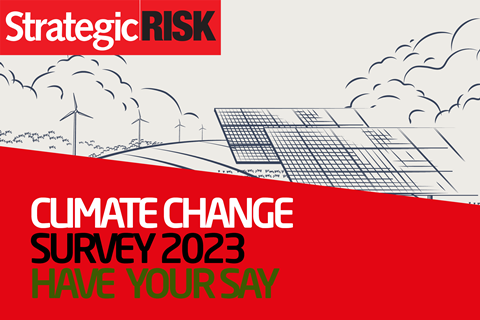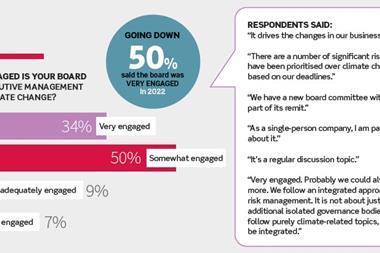As insurers grapple with increasingly frequent and severe natural catastrophes, the insurability of cat risks is being called into question, with worrying implications for risk managers.
Global Insurance Law Connect has launched the fifth edition of its annual ‘Risk Radar Report’.
For the first time, the research zeroes in on a single topic — Environment, Social and Governance — and highlights its worldwide impact on the insurance industry and the worrying knock-on effects for risk managers.

A collection of insights from leading specialist insurance law firms across 21 countries, the report details the growing awareness globally of ESG risks and how the insurance industry is well positioned to respond.
Gillian Davidson, chair of Global Insurance Law Connect, commented: “We are already seeing the significant impact of ESG on the insurance industry, for example with the dual governmental and social pressures of new regulation and stakeholder activism.
”The increased scrutiny of ESG strategies in many jurisdictions is also impacting directors’ and officers’ and financial institutions’ coverage, as well as professional indemnity policies for firms advising on climate-related financial disclosures.
”More needs to be done to meet governance and climate change risk assessment obligations”
“There is recognition within the insurance industry that embracing appropriate ESG policies can lead to significant growth opportunities, the creation of long-term value, and risk management benefits.
“While insurers have made advances in this area, more needs to be done to meet governance and climate change risk assessment obligations.”
What does it mean for risk managers?
As the GILC Risk Radar notes, ESG has become an increasingly important issue, with implications for both insurance buying and risk management practices.
With climate-related claims rising as insurers grapple with increasingly frequent and severe natural catastrophes, the insurability of cat risks across a number of regions and classes of insurance business is being called into question, with worrying implications for risk managers.
Increased scrutiny of ESG strategies across many jurisdictions - from regulators as well as stakeholder activists - is widely expected to impact insurance policies for directors’ and officers’ (D&O) and financial institutions’ (FI) risks in the near future, while professional indemnity (PI) policies for firms advising on climate-related financial disclosures could also be affected.
”The insurability of cat risks across a number of regions and classes of insurance business is being called into question, with worrying implications for risk managers”
In the UK in particular, this is expected to prompt more rigorous scrutiny of proposal forms by insurers as they assess businesses’ ESG exposures and the likely impact on FINPRO coverage.
Meanwhile, against a backdrop of geopolitical risks, supply chain disruptions and inflationary pressures, organisations are coming under increasing strain as they aim to strike the right balance between investing in ESG, exploring new risk mitigation strategies, and managing increasing costs – including the price of their insurance coverage.
Risk managers will also need to be increasingly aware of the growing regulatory risk around related issues, such as accusations of greenwashing, corporate disclosures in relation to TCFD requirements, and FCA guidelines on identifying businesses’ ESG risks
What next?
For risk managers in carbon-intensive industries, the impact of ESG is making it harder for businesses to find viable insurance options.
As developments in Brazil have indicated, regulatory activity around ESG could present challenges to corporate insurance buyers.
With the publication of Brazilian regulator SUSEP’s Circular No. 666, insurers will increasingly be expected to factor ESG considerations into underwriting decisions, making it much harder for insurance buyers in sectors with high environmental exposure, such as agriculture and heavy industry, to find coverage.
And the direct impact of climate change on property catastrophe exposures has risen to the top of the agenda for risk managers of businesses in increasingly cat-prone regions such as Australasia and the US.
”Organisations that rely on carbon-intensive production are struggling to find insurance options”
The multi-billion dollar flood losses experienced in Australia last year will have been passed onto policyholders in the form of higher premiums, while in some of the worst affected regions, such as Queensland, under-insurance remains a concern.
In New Zealand, extreme weather events are also affecting not only the cost and availability of insurance coverage for commercial property, but also political and regulatory action on mitigation efforts, including tighter controls on land use and construction in cat-prone areas.
The US experienced one of the costliest storms ever last year with Hurricane Ian which, combined with a higher frequency of climate-related natural catastrophe in the country, is making certain regions either very high risk – and therefore expensive - to insure.
”It is no longer just about mitigation but adapting our way of living”
In some cases, this is making it almost impossible for risk managers to secure coverage at any price.
Davidson said: “Organisations that rely on carbon-intensive production are struggling to find insurance options, and it is increasingly difficult in many parts of the world to underwrite business for frequent and severe natural catastrophe events.
“One of our member firms emphasised the importance of taking the right stance in the current debate, citing that it is no longer just about mitigation but adapting our way of living.
”Insurers can contribute to this transformation by being early adopters of ESG best practices and supporting ESG principles in their policies.”





















No comments yet